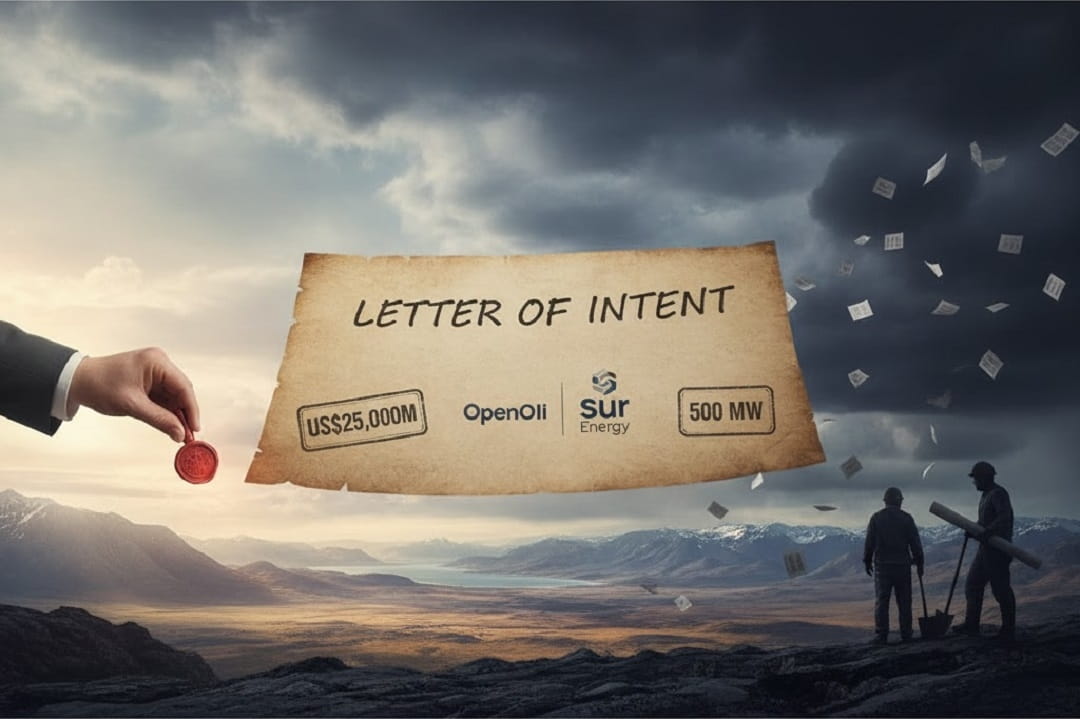A critical analysis of the official announcement: what was communicated, what is behind the 'letter of intent', signs of plausibility, and why some experts talk about political marketing.
1) Introduction - the announcement that shook headlines.
The Argentine government announced that OpenAI and the local company Sur Energy signed a letter of intent for a mega infrastructure project in Patagonia, with a potential investment of up to US$25.000 million and a capacity of up to 500 MW for data centers.
The headline was immediately interpreted as a historical scoop: is it a real installation in southern Argentina or an announcement with dual political and media purposes?
2) What did the official note say exactly? (facts that are indeed documented)
The key pieces that can indeed be verified in the announcements and coverage:
A letter of intent was signed between OpenAI and Sur Energy to explore a data center project in Argentina with a scale of up to 500 MW.
The operation would be framed within the incentive regime (RIGI) announced by the government to attract technological investments.
Various international media (Reuters, Yahoo Finance, BNAmericas, and others) reproduced the news based on government information and local press releases.
3) Why is there skepticism? - signals that call for caution
Not everything that shines is immediate investment. The reasons why analysts and local media warn caution:
Letter of intent ≠ firm contract. A letter of intent indicates interest and preliminary conditions but does not obligate investment nor set an execution timeline.
Amounts and timelines poorly detailed. The amount "up to US$25,000 million" is presented as a theoretical ceiling; there is no disbursement schedule or concrete public milestones.
Political and communication context. In Argentina, large-scale projects are often announced at early stages to generate a perception of achievement; some local editorials interpret it as a communication victory.
Pending critical infrastructure. A 500 MW center requires environmental permits, transmission lines, dedicated gas/energy, and logistics, elements that take years to materialize and were not resolved in the official note.
4) What does each party gain? - aligned (and contradictory) interests
OpenAI: access to cheap energy and regional talent, geographical diversification of Stargate infrastructure, and favorable narrative in emerging markets. The company has already presented global infrastructure initiatives (Stargate / OpenAI for Countries).
Sur Energy and the Argentine government: international projection, announced investment that reinforces the agenda of attracting capital and creating jobs (although materialization is another phase).
Local politics: announcements of this caliber usually impact public perception and can function as an image boost, independent of real technical progress.
5) Plausible scenarios (from the most optimistic to the most cautious)
Gradual reality: OpenAI confirms interest, a binding agreement is signed in 12–24 months, and construction begins in 2–3 years (most constructive scenario).
Conditional agreement: the LOI transforms into a memorandum with milestones and conditions (permits, financing, partners), and the project dissolves if not fulfilled.
Political marketing: the LOI fulfills its communicational function; the investment ends up being symbolic or very reduced compared to the announced amount.
6) What should be observed in the coming weeks? - signals that validate the news.
Joint official publications with technical details (exact location, timeline, financing).
Confirmations from OpenAI on their official channel (newsroom/releases).
Contracts with energy suppliers or infrastructure manufacturers (AMD, Samsung, etc.) that link to the project.
Federal and provincial environmental permits published.
Movements in the stock market or local actors (Sur Energy, electric companies) that reveal purchases or partnerships.
7) Journalistic and critical reading recommendations
Key distinction: “letter of intent” vs “firm contract”. Do not treat both terms as equivalents.
Seek primary sources (OpenAI announcement, official records, contracts) before accepting amounts and dates.
Cross-check statements from officials with documents and public timelines.
Encourage coverage with questions about energy, environmental impact, and long-term thinking (employment, local training, technology transfer).
8) Conclusion
The announcement of the LOI between OpenAI and Sur Energy has the potential to be a milestone for Argentina if it turns into real and verifiable commitments.
For now, the available information confirms interest and an intention to explore a megaproject in Patagonia, but years of technical negotiation, permits, and financing lie ahead.
In clear language: there is real news, but also ingredients of political communication; informative caution is essential.
Key sources (selected): Reuters / coverage on letter of intent and amount and capacity; BNAmericas on participation in Stargate and technical details; OpenAI Newsroom (for Stargate / OpenAI for Countries initiatives); Buenos Aires Times and local editorials analyzing the possible political character of the communication.
Disclaimer: This article is informative and analytical; it does not constitute legal, technical, or investment advice. Decisions regarding infrastructure projects should be based on official documentation and expert opinions.
#OpenAI #ArgentinaCripto #BinanceSquare #AI #trending

